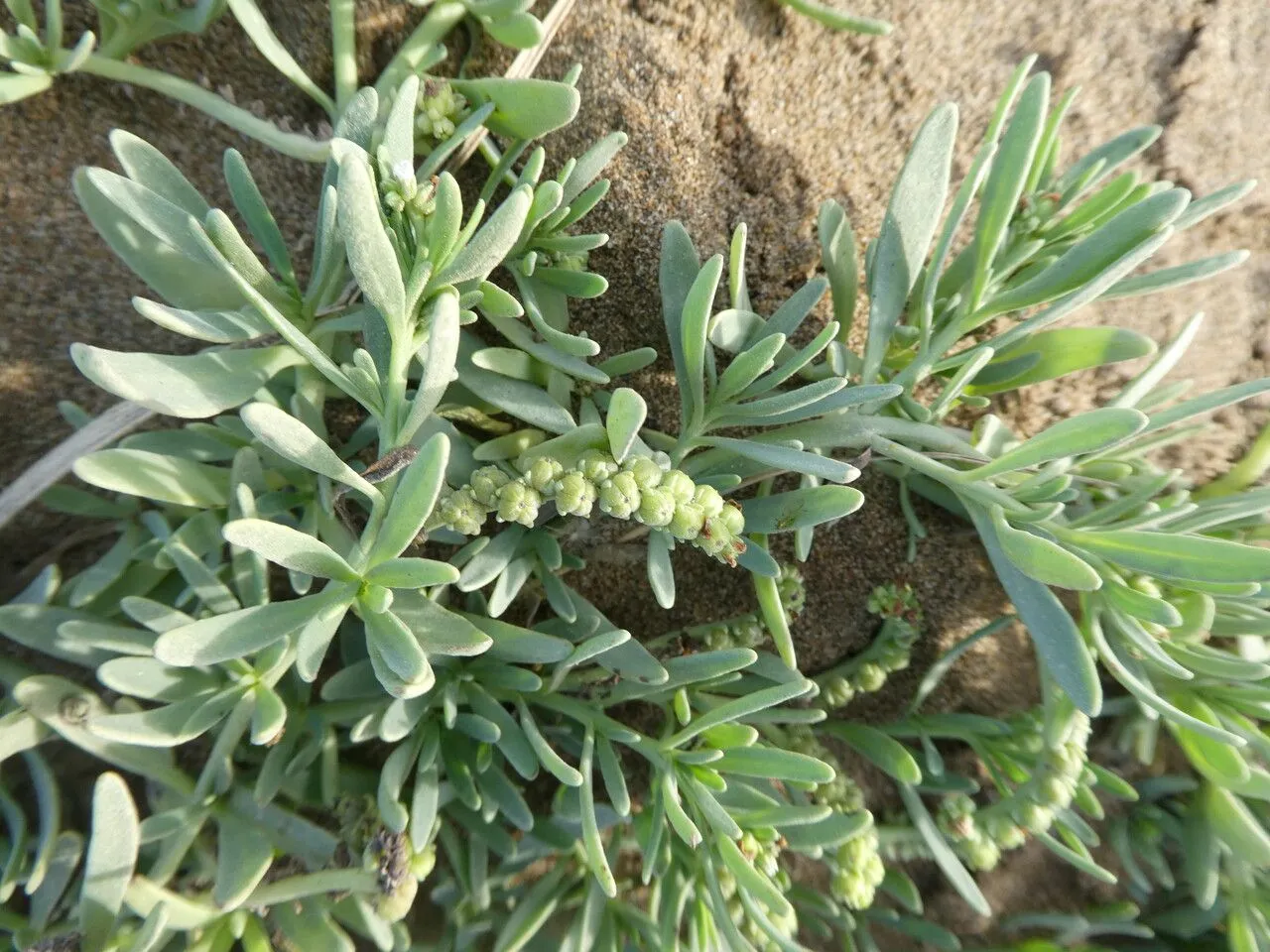
Author: L.
Bibliography: Sp. Pl.: 130 (1753)
Year: 1753
Status: accepted
Rank: species
Genus: Heliotropium
Vegetable: False
Observations: Australia, Hawaiian Is., Trop. & Subtrop. America
Smooth heliotrope, known scientifically as Heliotropium curassavicum, is an intriguing and resilient species belonging to the Boraginaceae family. Classified by the renowned botanist Carl Linnaeus in his seminal work “Species Plantarum” in 1753, Heliotropium curassavicum has since captivated botanists and plant enthusiasts alike with its unique characteristics and widespread presence.
This hardy perennial herb is native to the far-reaching regions of tropical and subtropical America but has successfully expanded its habitat to various other locales, including Australia and the Hawaiian Islands. Its adaptability to diverse environments has marked it as a prominent example of ecological resilience and flexibility.
Smooth heliotrope typically manifests with prostrate or ascending stems that can stretch up to a meter in length. These stems are often adorned with narrow, oblong leaves that offer a lush green hue, lending a verdant charm to the plant’s overall appearance. The texture of the foliage aligns with its common name, presenting a smooth and somewhat succulent aspect to the touch.
The blossoming phase of Heliotropium curassavicum is particularly enchanting. The plant produces clusters of small, tubular flowers that are usually white but may occasionally display shades of light blue or lavender. These delicate blooms, coupled with their faint, sweet fragrance, make the smooth heliotrope an attractive presence in its natural habitats, attracting a variety of pollinators including bees and butterflies.
An important aspect of smooth heliotrope is its adaptability to different soils, particularly saline and alkaline conditions, which often hinder the growth of less tolerant species. This characteristic enables the plant to thrive in coastal areas, salt marshes, and disturbed inland habitats, thereby contributing to ecosystem diversity and stability in such regions.
Despite its beauty and resilience, it’s important to note that smooth heliotrope contains certain alkaloids that can be toxic to livestock if ingested in significant quantities. Thus, while it offers ecological benefits, it also necessitates mindful management in areas where livestock grazing is prevalent.
In summary, Heliotropium curassavicum stands out as a remarkable and versatile plant species, renowned for its delicate beauty, robust adaptive capabilities, and significant role in various ecosystems. Whether flourishing in its native tropical and subtropical American habitats or making its presence known in distant regions like Australia and the Hawaiian Islands, the smooth heliotrope continues to capture the interest and admiration of those who study and encounter it.
Spa: alacranillo de mar, verruguera
Deu: curacao-sonnenwende
Ita: eliotropio marino
Fra: héliotrope de curaçao
Dan: middelhavs-heliotrop
Eng: salt heliotrope, seashore heliotrope, seaside heliotrope, smooth heliotrope, seaside lavender, alkali heliotrope, quail plant
Por: crista-de-galo, tornassol-sem-pêlos, verrucária-sem-pêlos
Swe: strandheliotrop, köttheliotrop
En: Smooth heliotrope, Seaside heliotrope, Seashore heliotrope, Salt heliotrope, Seaside Lavender, Alkali heliotrope, Quail plant
Ar: رحب (رَحَب)، رحابه (رَحابَه، رُحابه), غبيره (غُبِّيره، غُبَّيره)، رحى (رَحى)
Da: Middelhavs-heliotrop
Fr: Héliotrope de Curaçao
De: Curacao-Sonnenwende
He: עוקץ-עקרב בשרני
It: Eliotropio marino
Pt: Crista-de-galo, Tornassol-sem-pêlos, Verrucária-sem-pêlos
Es: Alacranillo de mar, Verruguera
Sv: Strandheliotrop, Köttheliotrop
Taken Dec 25, 2021 by Trap Hers (cc-by-sa)
Taken Apr 28, 2021 by Sohail khan (cc-by-sa)
Taken Oct 17, 2020 by Llandrich anna (cc-by-sa)
Taken Jul 14, 2017 by Tela Botanica − Liliane ROUBAUDI (cc-by-sa)
Taken Oct 17, 2020 by Llandrich anna (cc-by-sa)
Taken Jul 14, 2017 by Tela Botanica − Liliane ROUBAUDI (cc-by-sa)
Taken Jul 14, 2017 by Tela Botanica − Liliane ROUBAUDI (cc-by-sa)
Taken Jan 5, 2022 by Jason Springer (cc-by-sa)
Taken Nov 11, 2021 by Dr Sandeep Kumar Yadav Sandeep (cc-by-sa)
Taken Oct 17, 2020 by Llandrich anna (cc-by-sa)
Taken Dec 28, 2021 by Trap Hers (cc-by-sa)
Taken Nov 11, 2021 by Dr Sandeep Kumar Yadav Sandeep (cc-by-sa)
Taken Jul 14, 2017 by Tela Botanica − Liliane ROUBAUDI (cc-by-sa)
Taken Oct 17, 2020 by Llandrich anna (cc-by-sa)
Taken Oct 17, 2020 by Llandrich anna (cc-by-sa)
Taken Jul 14, 2017 by Tela Botanica − Liliane ROUBAUDI (cc-by-sa)
Taken Jul 14, 2017 by Tela Botanica − Liliane ROUBAUDI (cc-by-sa)
Taken Oct 17, 2020 by Llandrich anna (cc-by-sa)
Taken Oct 17, 2020 by Llandrich anna (cc-by-sa)
Taken Jul 14, 2017 by Tela Botanica − Liliane ROUBAUDI (cc-by-sa)
Taken Jul 15, 1998 by Photoflora – Benoit BOCK (©)
Taken Aug 30, 2014 by EOL − Lee Elliott (cc-by-nc-sa)
Taken May 24, 2015 by EOL − Moorpark College Biology Club (cc-by-nc)
Taken Mar 24, 2021 by Delgado Miguel (cc-by-sa)
Taken Oct 17, 2020 by Llandrich anna (cc-by-sa)
© copyright of the Board of Trustees of the Royal Botanic Gardens, Kew.
© copyright of the Board of Trustees of the Royal Botanic Gardens, Kew.
© copyright of the Board of Trustees of the Royal Botanic Gardens, Kew.
Taken Jun 23, 2011 by Tela Botanica − Bertrand BUI (cc-by-sa)
Taken May 8, 2012 by Tela Botanica − Liliane Roubaudi (cc-by-sa)
Taken Sep 1, 2022 by Alsanabani Jamal (cc-by-sa)
Taken Jan 1, 1970 by Photoflora – L’Abbé COSTE (©)
Taken Dec 29, 2020 by Samira Alqatari (cc-by-sa)
Growth form: Rhizomatous
Growth habit: Forb/herb, Subshrub
Growth rate: Moderate
Ph maximum: 8.5
Ph minimum: 6.5
Light: 8
Atmospheric humidity: 8
Bloom months: [‘jun’, ‘jul’, ‘aug’, ‘sep’, ‘oct’]
Soil nutriments: 7
Soil salinity: 8
Family: Myrtaceae Author: (F.Muell.) K.D.Hill & L.A.S.Johnson Bibliography: Telopea 6: 402 (1995) Year: 1995 Status:…
Family: Rubiaceae Author: Pierre ex A.Froehner Bibliography: Notizbl. Bot. Gart. Berlin-Dahlem 1: 237 (1897) Year:…
Family: Sapindaceae Author: Koidz. Bibliography: J. Coll. Sci. Imp. Univ. Tokyo 32(1): 38 (1911) Year:…
Family: Asteraceae Author: A.Gray Bibliography: Pacif. Railr. Rep.: 107 (1857) Year: 1857 Status: accepted Rank:…
Family: Fabaceae Author: Medik. Bibliography: Vorles. Churpfälz. Phys.-Ökon. Ges. 2: 398 (1787) Year: 1787 Status:…
Family: Aspleniaceae Author: (Cav.) Alston Bibliography: Bull. Misc. Inform. Kew 1932: 309 (1932) Year: 1932…